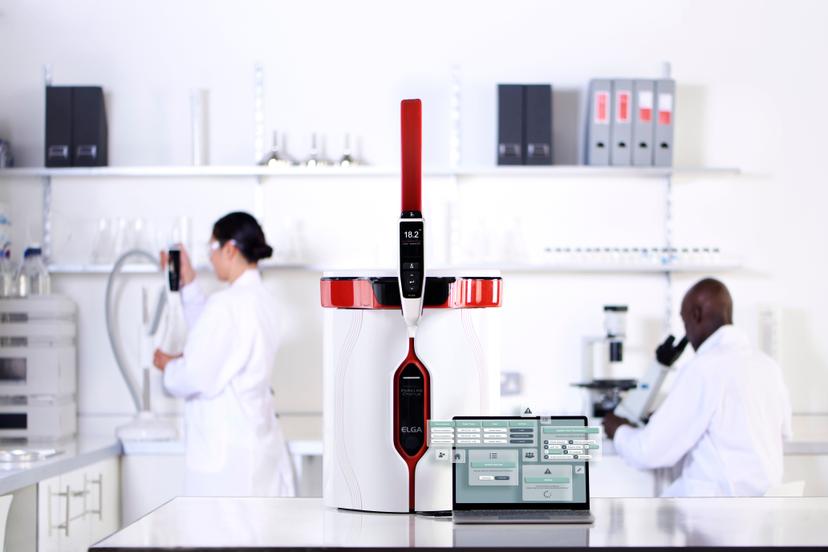Pharma quality control: Meet the system producing compliant water
26 Jul 2022

Ultrapure water systems are a vital component of pharmaceutical quality control (QC) laboratories. These ultrapure water systems function by removing chemical contaminants through reverse osmosis, de-ionization (DI) and ultra-filtration. Even though these systems are highly effective, searching for a reliable water purification system can be a challenge. In this article, we explore some of the key bottlenecks associated with the use of water in pharmaceutical QC and introduce the PURELAB® Pharma Compliance system from ELGA LabWater, a system designed to help QC laboratories produce reliable and consistent laboratory grade water that complies with current regulations and best practice guidelines.
Water is one of the most widely used substances in drug production and serves many roles including functioning as an ingredient, a cleaning agent, and a reagent. Extensive regulations govern the use of water by drug manufacturers and water purification systems. The associated validation support services are also subject to stringent Good x Practice (GxP) requirements. There are also additional standards that apply to water use in QC laboratories, such as the requirement to have an electronic signature audit trail, and users must comply with the total organic carbon (TOC) verification and water conductance requirements of the United States Pharmacopeia (USP 643 and 645). Take a look at this whitepaper for more information about the regulatory requirements.
Meeting all these requirements can pose many challenges for pharmaceutical laboratories to overcome. Here we will address some of these setbacks and solutions in three different areas:
How can we ensure that water used in drug production and QC complies with regulatory guidelines?
How can we ensure the water used for producing active pharmaceuticals ingredients (APIs) meets specifications?
How can water help when QC goes wrong?
Ensuring water used in QC complies with regulatory guidelines
It is essential that drug manufacturers are confident the water they are using for drug production and QC is of a high quality, including being free from microbial and chemical contaminants. Unlike other ingredients, water used for these processes is usually drawn from a system “on demand” and is not subject to dedicated testing and batch or lot release before use. Therefore, the industry needs water purification systems that comply with current regulations and have Standard Operating Procedures (SOPs) that are traceable and can be validated.
To ensure water is of high quality and free from contaminants, water purification systems should be qualified following the World Health Organization (WHO) validation convention of design review or design qualification (DQ), installation qualification (IQ), operational qualification (OQ) and performance qualification (PQ). For water purification systems, this qualification should take place over three phases. In the first phase, the system should operate continuously for a test period of 2–4 weeks with intensive monitoring using appropriate chemical and microbiological QC tests. During this period, the SOPs for operation, maintenance, sanitization, and troubleshooting should be used and refined. Once this has been achieved, the refined SOPs should be followed in a second test period of 2–4 weeks with intensive monitoring. During this second phase, the water produced by the system can be used for drug production testing.
The final phase of the qualification process aims to demonstrate the system is reliable over an extended period of time and typically runs for a further year alongside drug production. QC testing is less intensive during this phase and should follow the normal routine pattern based on the procedures developed during the first two phases.
Creating water of the highest quality
In the pharmaceutical industry, water for injection (WFI) refers to any water that is destined to be ingested by humans. WFI is the highest quality of water for pharmaceutical use and should be prepared from potable water as a minimum-quality feedwater. It has many uses, including injectable product preparations, dissolving, or diluting substances, and for the final rinse after cleaning equipment and components that come into contact with injectable products. To ensure that water meets WFI specifications and be fully confident that any QC issues are due to other ingredients and not water quality, water purification systems should meet current Good Manufacturing Practice (cGMP) or equivalent regulations.
Microbial contamination is a big concern for pharmaceutical QC. Some types of microorganism may proliferate and produce biofilms in water treatment components, and within the systems used to store and distribute the water. The results to check the microbial quality of water often lag behind the water use because many of these tests require periods of incubation. Therefore, it is very important to minimize microbial contamination by routinely sanitizing the equipment used to treat, store, and distribute water and taking appropriate measures to prevent microbial proliferation. Therefore, the sanitization process must be traceable and validated.
How can we ensure the water used for producing active pharmaceuticals ingredients (APIs) meets specifications?
Water is used extensively as a starting material in the production, processing, and formulation of active pharmaceutical ingredients (APIs), intermediates and finished pharmaceutical products (FPP). Poorly manufactured or compromised APIs may result in unsafe and ineffective medicines that could cause illness or even the death of patients.
Therefore, it is important to carefully control what grade of water is used at each step in the manufacturing process. The quality of water required depends on the stage of synthesis of the API, the stage in the whole drug manufacturing process, the subsequent processing step and the nature of the final product.
It is often possible to use deionized or municipal water for the initial and intermediate API steps if there will be a further addition of solvents and/or distillation prior to manufacturing the final API. These further steps minimize the growth of microorganisms and the impact of contaminants on the final API. The manufacture of the final API and the final rinse of equipment and containers generally require water that has been purified to the strict USP or European Pharmacopeia (EP) standards. Therefore, for these final stages, it is important to use water purification systems that fully comply with these standards to ensure that water quality is measured and automatically recorded throughout the QC process. Such systems also minimize the risk of human error causing delays in the manufacturing process.
When QC goes wrong
The QC process is an important safety net in drug production. If poor-quality medicines slip through this net and are distributed to patients, this can cause serious problems, including a lack of therapeutic benefit, toxic or adverse reactions, and a waste of limited financial resources. It can also cause the entire healthcare system to become less effective and harm public confidence. All batches of substandard drugs will need to be recalled, which requires manufacturers to have good record keeping and effective communication with distributors.
To be able to rule out whether water is a cause of any QC problems, and to achieve maximum sensitivity in QC tests, laboratories should use water purification systems that comply with current regulations. QC testing can be split into three types: analytical testing, microbiological testing and compendial analysis, which use a range of analytical and microbiological tests to ensure the final product meets pharmacopeia standards. For most analytical techniques, such as high-performance liquid chromatography (HPLC), liquid chromatography-mass spectroscopy (LC-MS) and enzyme-linked immunosorbent assay (ELISA), Type I water is generally required. Alternatively, sterile Type II water will usually be sufficient for microbiological testing.
Along with following the WHO guidelines for qualification (DQ/IQ/OQ/PQ), water purification systems should be simple to use, with plug and play compliance so that the water they produce is constantly monitored and validated upstream of all QC tests.
How can PURELAB® Pharma Compliance help?
ELGA LabWater are specialists in developing and servicing water purification systems with over 80 years of experience. Their latest product, PURELAB® Pharma Compliance, combines ELGA’s ultrapure water purification system with software, qualification documentation and global support services designed to enable QC laboratories to perform all the validation required to meet Good Manufacturing Practice (GMP).
The system delivers 18.2MΩ ultrapure water using purification processes that are designed to fulfil USP standards 643 and 645. The software included with the product is secure and provides the evidence to meet FDA and EU standards for digital record keeping. Furthermore, the system is supported by ELGA’s global network of support teams, who have many years of experience supporting laboratory equipment subject to validation under cGMP. PURELAB® Pharma Compliance can also effectively integrate within any QC laboratory, it is user-friendly, modular, and stackable to save space, and it uses consumables that minimize costs and environmental waste.
Water is used throughout the manufacture and QC testing of pharmaceuticals, so it is important to consider the quality of water both from the perspective of it being an ingredient in itself, as well as being a key cleaning agent and reagent. By providing an easy-to-use, compact water purification system that fully complies with pharmacopeia and WHO guidelines, PURELAB® Pharma Compliance from ELGA LabWater offers QC laboratories a simple, automated, and traceable way to consistently produce high quality water.

